Research shows project managers waste nearly 4 hours weekly on manual reporting, while AI can slash that to minutes. Add predictive insights, and projects suddenly run smoother, risks shrink, and resources stretch further.
That’s why exploring how to use AI in project operational management is quickly becoming the difference between projects that crawl and projects that deliver.
In this article, we will:
- Walk through a 12-week AI roadmap to transform project operations
- Apply proven prompt patterns that generate reliable AI outputs
- Measure success with clear metrics that demonstrate AI’s value to leadership
AI project operational management: Your complete implementation roadmap
Implementing artificial intelligence in project operational management doesn't have to be overwhelming.
With the right approach, you can transform your operations from manual, time-consuming processes into streamlined, intelligent workflows that deliver better outcomes faster.
The key is starting small and building systematically.
Follow this 12-week implementation roadmap to successfully integrate AI into your project operations and see measurable results from day one.
Step 1 - Start with administrative task automation (week 1-2)
The foundation of AI-powered project operations begins with eliminating the mundane administrative tasks that consume valuable time. This first step focuses on automating routine activities that project managers spend hours on weekly, creating immediate time savings that can be redirected toward strategic work.
Implement AI meeting management:
- Install AI tools for automatic meeting transcription and note-taking
- Set up automated action item extraction and assignment
- Configure automatic meeting summary distribution to stakeholders
- Create AI-powered follow-up reminders for pending tasks
Pro tip: Start with your most frequent meeting types (daily standups, weekly reviews) to maximize impact. Most teams save 2-3 hours per week just from automated meeting documentation.
Deploy email and communication automation:
- Use AI email classification tools to automatically sort project communications
- Set up intelligent routing of support requests to appropriate team members
- Implement chatbots for common project status inquiries
- Configure automated project update notifications based on milestone completion
Automate status reporting:
- Connect Dart's AI reporting features to generate automated dashboards
- Set up an automated dashboard generation showing project health metrics
- Configure weekly/monthly automated progress reports for stakeholders
- Implement real-time project status updates using AI data aggregation
Implementation insight: Administrative automation typically delivers the fastest ROI, with most organizations seeing measurable time savings within the first two weeks of deployment.
Step 2 - Optimize resource planning and allocation (week 3-4)
Smart resource management is where AI truly shines in project operations. By analyzing team capabilities, availability, and project requirements, AI can make optimal assignments that human managers might miss, leading to better utilization and reduced burnout.
Implement AI-driven resource matching:
- Use AI integrations to analyze team skills vs project requirements
- Set up automated task assignment based on team member availability and expertise
- Configure workload balancing algorithms to prevent team burnout
- Implement predictive staffing recommendations for upcoming project phases
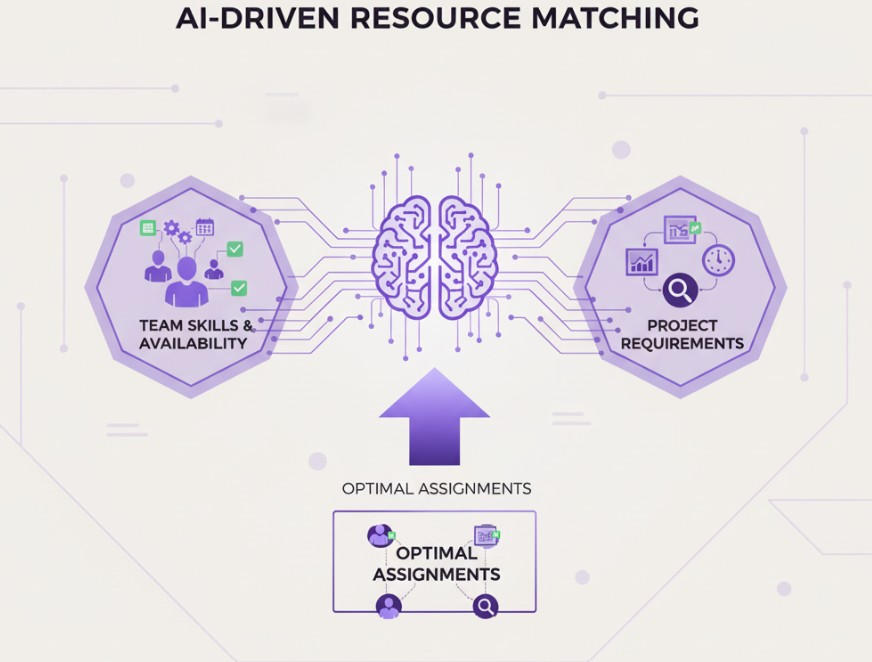
Deploy intelligent scheduling:
- Use Dart's AI task management for dynamic schedule optimization
- Set up dependency-aware scheduling that automatically adjusts timelines
- Configure AI-powered calendar management for team coordination
- Implement automated conflict resolution for resource double-booking
Strategic advantage: AI scheduling can identify optimal work patterns for individual team members, scheduling complex tasks during their peak performance hours.
Establish capacity planning systems:
- Deploy AI tools that analyze historical project data to predict future resource needs
- Set up early warning systems for potential resource shortages
- Configure automated hiring or contractor engagement recommendations
- Implement cross-project resource optimization algorithms
Key benefit: AI-driven resource allocation typically increases billable hour utilization by 20-25% while reducing project delivery times significantly.
Step 3 - Implement predictive risk management (week 5-6)
Traditional risk management is reactive, but AI enables proactive risk identification and mitigation. By analyzing patterns from past projects and current data, AI can predict potential issues before they become critical problems.
Set up AI risk assessment:
- Deploy AI tools for automated risk identification
- Configure machine learning models using your historical project data
- Set up real-time risk scoring based on project metrics and external factors
- Implement automated risk mitigation strategy recommendations
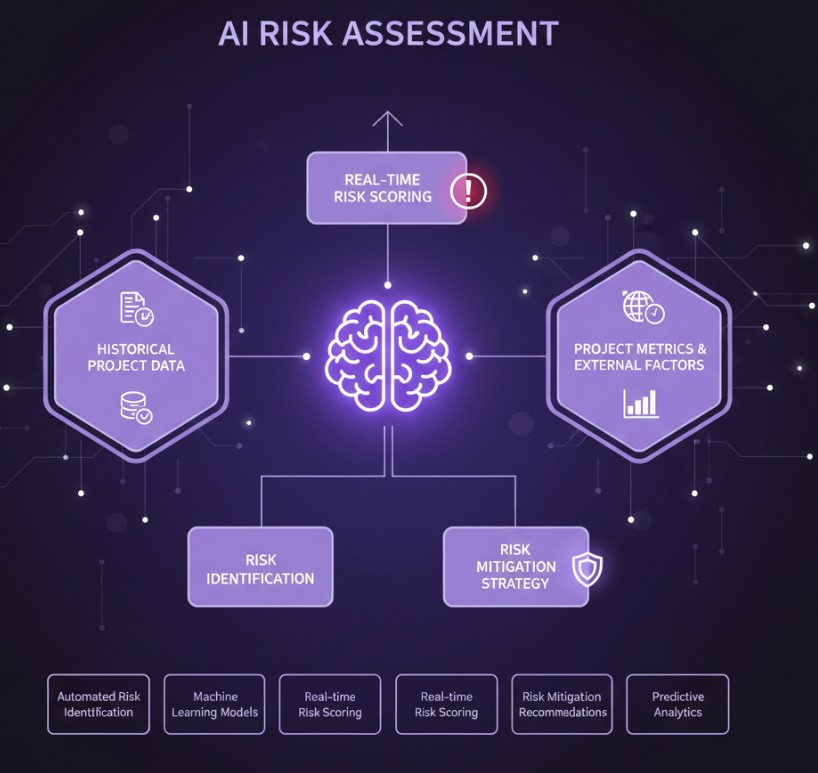
Create intelligent quality control:
- Use AI-powered testing and quality assurance tools
- Set up automated compliance checking against project standards
- Configure predictive quality metrics based on team performance patterns
- Implement automated quality gates that prevent substandard deliverables
Critical advantage: AI risk management can identify potential budget overruns 4-6 weeks earlier than traditional methods, enabling proactive cost control.
Deploy predictive analytics:
- Install business intelligence tools with AI capabilities
- Set up predictive models for project timeline accuracy
- Configure budget overrun prediction and early warning systems
- Implement success probability scoring for project phases
Risk reduction benefit: Organizations using AI risk management report 30-40% fewer project failures and cost overruns.
Step 4 - Optimize decision-making with AI insights (week 7-8)
Data-driven decision making becomes effortless when AI transforms raw project data into actionable insights. This step focuses on creating intelligent systems that support better strategic choices at every level of project management.
Implement intelligent project dashboards:
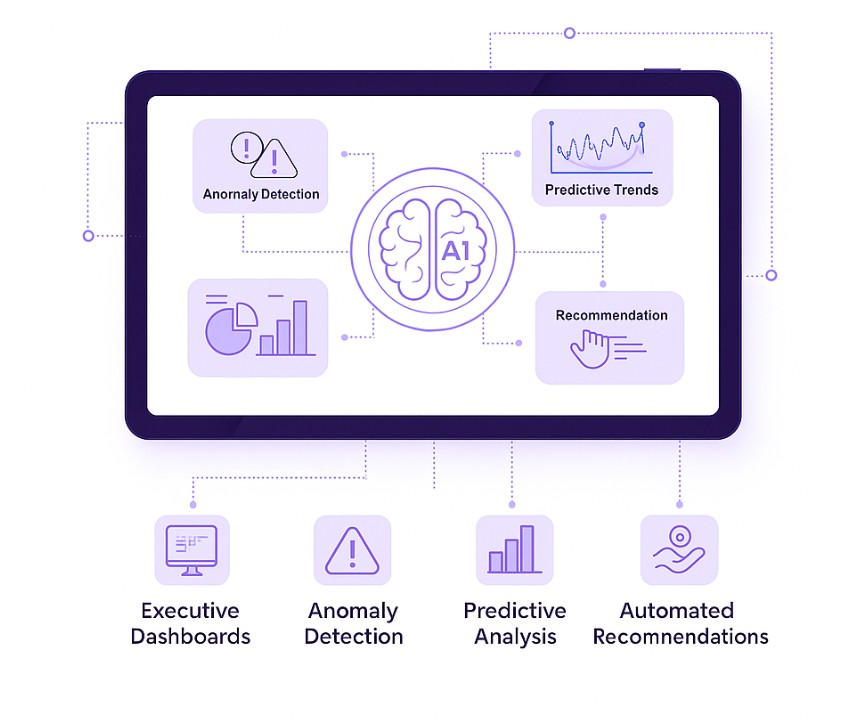
- Create AI-powered executive dashboards using Dart's visualization features
- Set up automated anomaly detection for project performance metrics
- Configure predictive trend analysis for strategic planning
- Implement automated recommendations for project course corrections
Deploy smart communication systems:
- Use AI to analyze stakeholder communication patterns and preferences
- Set up intelligent notification systems that adapt to individual preferences
- Configure automated conflict detection in team communications
- Implement AI-powered sentiment analysis for team morale monitoring
Strategic insight: AI communication analysis can identify team stress indicators 2-3 weeks before they impact project performance, enabling proactive intervention.
Create data-driven decision support:
- Set up AI models that recommend optimal project prioritization
- Configure automated "what-if" scenario analysis for major decisions
- Implement AI-powered vendor and contractor evaluation systems
- Deploy intelligent budget reallocation recommendations
Decision speed improvement: Teams using AI-powered decision support make strategic choices 50% faster with greater accuracy.
Step 5 - Scale and integrate advanced AI features (week 9-12)
The final phase transforms your project operations into a self-improving system that learns from every project and continuously optimizes performance. This is where AI moves from tool to strategic advantage.
Implement cross-project intelligence:
- Deploy AI systems that learn from all projects to improve future planning
- Set up automated best practice identification and sharing
- Configure intelligent project template generation based on successful patterns
- Implement AI-powered post-project analysis and lessons learned extraction
Deploy advanced automation:
- Set up AI-powered contract and vendor management
- Configure intelligent procurement and supply chain optimization
- Implement automated regulatory compliance monitoring
- Deploy AI-driven customer communication and expectation management
Performance benchmark: Organizations completing this full implementation typically see 35-40% improvement in project delivery speed and 25-30% reduction in operational overhead.
Create continuous improvement systems:
- Set up machine learning models that continuously optimize processes
- Configure automated performance benchmarking against industry standards
- Implement AI-powered innovation opportunity identification
- Deploy intelligent change management and adaptation systems
Success metric: By week 12, your AI-powered project operations should be delivering measurable improvements in efficiency, quality, and team satisfaction while providing predictive insights that enable proactive management of future challenges.
This systematic 12-week approach transforms manual operations into intelligent, self-optimizing systems that deliver consistent project success.
AI prompt engineering: Proven patterns for project operations success
The difference between AI that helps and AI that frustrates often comes down to how you ask. Effective prompt engineering transforms generic AI responses into precise, actionable project insights that drive real operational improvements.
Master these battle-tested prompt patterns to unlock AI's full potential in your project workflows.
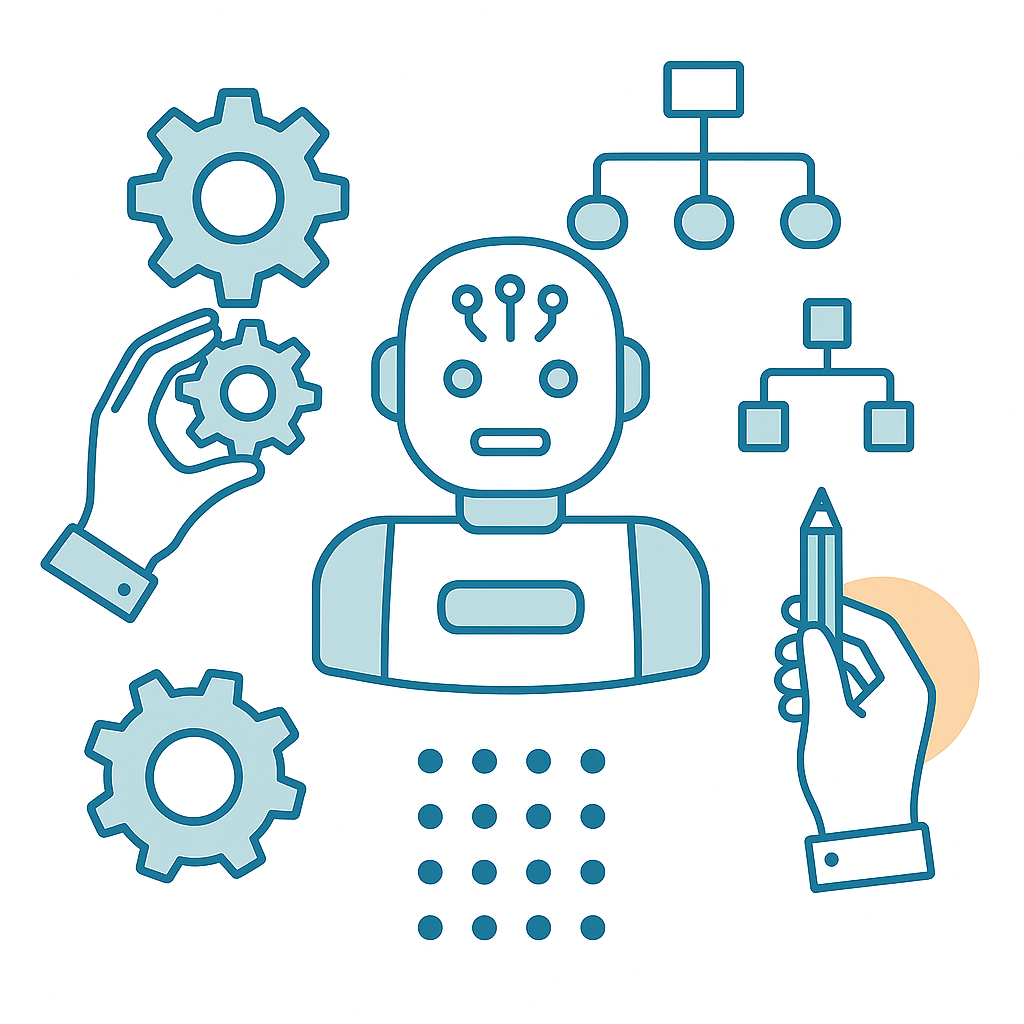
Meeting minutes to action items: Structured extraction template
Converting rambling meeting discussions into clear action items requires specific prompt architecture. The key is providing AI with a clear output structure and context boundaries to ensure nothing important gets lost in translation.
Proven prompt pattern:
Analyze this meeting transcript and extract action items using this format:
- **Action**: [specific task]
- **Owner**: [responsible person]
- **Deadline**: [due date]
- **Priority**: [high/medium/low]
Context: [project name and meeting type]
Constraints: Only include items with clear ownership. Flag unclear assignments as "needs clarification."
Essential guardrails: Always include "cite timestamp" and "flag ambiguous items" to maintain accuracy and accountability in your action tracking.
Risk identification to mitigation strategies: Intelligent analysis framework
Traditional risk logs capture problems, but AI can predict solutions. This pattern transforms reactive risk management into proactive mitigation planning by combining historical data with current context.
Strategic prompt structure:
Given this project risk: [risk description]
Project context: [timeline, budget, team size]
Historical data: [similar past projects]
Generate mitigation strategies with:
- **Immediate actions** (next 48 hours)
- **Short-term solutions** (1-2 weeks)
- **Long-term preventive measures**
- **Cost impact** for each option
Critical guardrails: Include "assess probability" and "provide confidence level" to ensure AI recommendations include uncertainty indicators rather than false certainty.
Status updates to executive summaries: Tone and clarity optimization
Executive stakeholders need different information depth than project teams. This pattern ensures AI adapts communication style while preserving essential details that matter for strategic decision-making.
Executive communication template:
Transform this detailed project status into an executive summary:
- **Audience**: [C-level/board/department head]
- **Length**: [2 paragraphs maximum]
- **Tone**: [professional, confident, solution-focused]
- **Include**: Key wins, critical risks, budget status, next milestone
- **Exclude**: Technical details, minor issues, team-specific updates
Quality guardrails: Always add "highlight data sources" and "flag low-confidence items" to maintain credibility. Include "suggest follow-up questions" to anticipate executive concerns.
These patterns transform AI from an experimental tool to a reliable operational partner that consistently delivers project insights you can trust and act upon.
Proving AI value: Essential metrics that convince leadership
Leadership demands concrete evidence that AI investments deliver measurable business impact. Abstract benefits like "improved efficiency" won't secure budget approval, but specific KPIs showing quantifiable improvements will turn skeptics into advocates.
Focus on these proven measurement frameworks to build an unshakeable business case for AI in project operations.
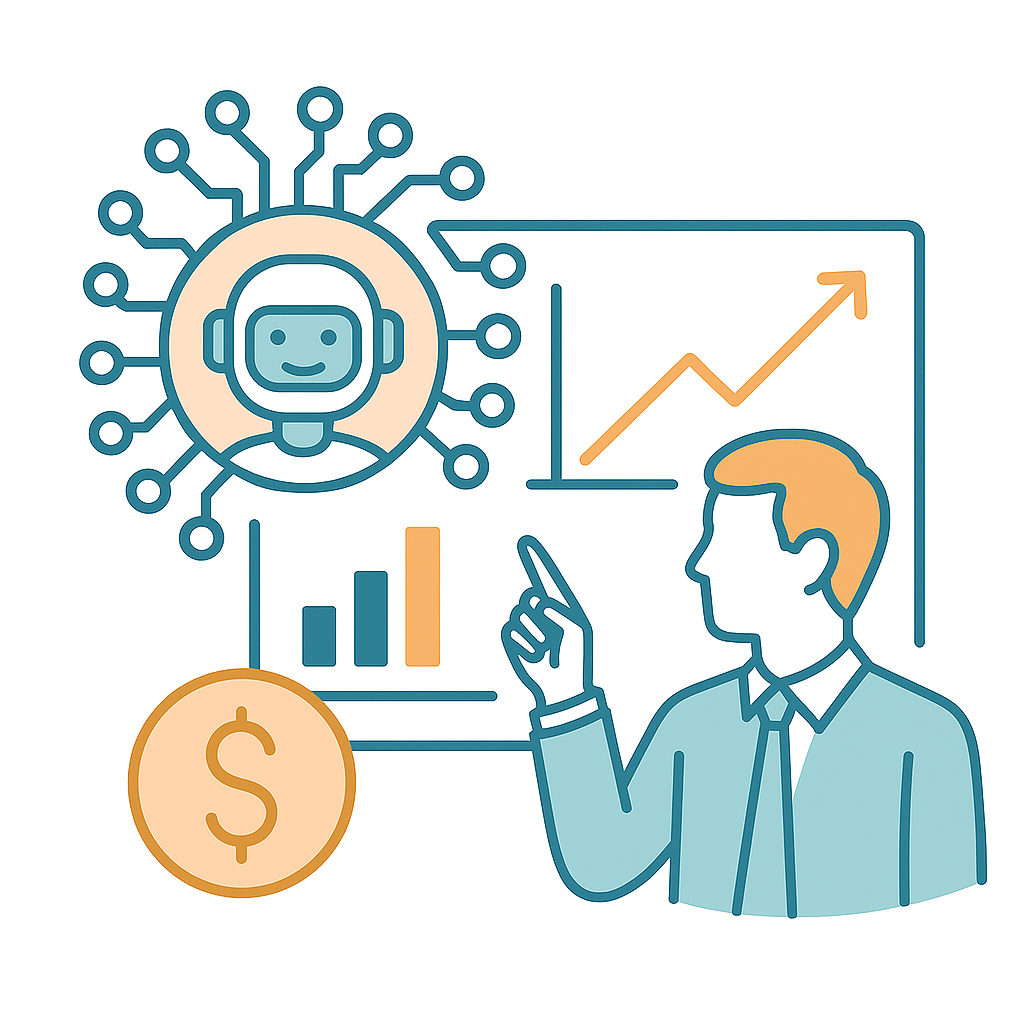
Cycle time reduction: Measuring speed improvements
Project delivery speed is the most visible indicator of operational improvement. Measuring cycle time changes provides clear before-and-after comparisons that leadership can immediately understand and appreciate.
Key measurement approach:
- Baseline measurement: Track the average project completion time before AI implementation
- Post-AI comparison: Measure identical project types after 90 days of AI usage
- Segment by complexity: Compare simple, medium, and complex project improvements separately
- Factor external variables: Account for team changes, scope adjustments, and seasonal impacts
Typical results: Organizations implementing AI project management see a 25-40% reduction in cycle times, with administrative-heavy projects showing the most dramatic improvements.
Executive reporting format: Present as "AI reduced project delivery time from 12 weeks to 8 weeks, enabling 3 additional client projects per quarter."
Resource utilization lift and variance reduction
Efficient resource allocation directly impacts profitability and team satisfaction. These metrics demonstrate AI's ability to optimize human capital while reducing the stress of poor planning and overallocation.
Critical metrics to track:
- Utilization rate increase: Percentage improvement in billable hours or productive time
- Workload variance reduction: Decreased gap between team members' workload distribution
- Overtime reduction: Lower emergency staffing and weekend work requirements
- Cross-training opportunities: Increased skill development through better resource matching
Measurement framework: Compare 3-month periods before and after AI implementation, controlling for seasonal variations and major organizational changes.
Leadership value proposition: Higher utilization rates directly translate to increased revenue per employee, while reduced variance improves retention and reduces burnout-related costs.
Forecast accuracy and rework reduction
Predictive accuracy improvements showcase AI's strategic value beyond operational efficiency. Better forecasting enables superior planning and risk management that prevents costly project failures.
Essential tracking metrics:
- Timeline prediction accuracy: Percentage improvement in delivery date estimates
- Budget variance reduction: Decreased gap between projected and actual costs
- Scope change frequency: Reduced mid-project modifications and requirement updates
- Quality metrics: Lower defect rates and rework percentages
ROI calculation method: Multiply rework reduction hours by average hourly cost, add budget variance improvements, and factor in opportunity costs from better forecasting.
Compelling presentation: "AI improved our project forecasting accuracy by 60%, preventing $240,000 in cost overruns and enabling proactive resource reallocation across 15 active projects."
These metrics transform AI from experimental technology into essential operational infrastructure that leadership recognizes as fundamental to competitive advantage.
Shift from task overload to intelligent resource use
AI in project operational management is not just about automating busywork; it’s about freeing teams from overload and channeling effort into meaningful outcomes.
By following a structured roadmap, applying smart prompt patterns, and tracking KPIs that matter, you transform operations into a system that predicts risks, optimizes resources, and drives results. The organizations that act now will not just save hours, they’ll unlock a competitive edge built on intelligence, foresight, and consistent delivery.


%20(1).jpg)
_light%201.png)





